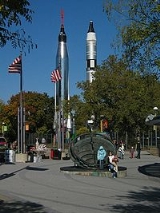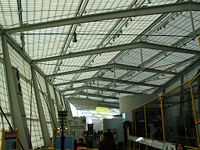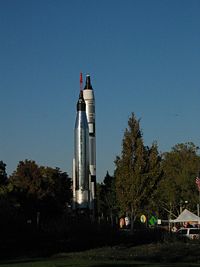
New York Hall of Science
Encyclopedia


The New York Hall of Science occupies one of the few remaining structures of the 1964 New York World's Fair
1964 New York World's Fair
The 1964/1965 New York World's Fair was the third major world's fair to be held in New York City. Hailing itself as a "universal and international" exposition, the fair's theme was "Peace Through Understanding," dedicated to "Man's Achievement on a Shrinking Globe in an Expanding Universe";...
in Flushing Meadow-Corona Park in the borough
Borough (New York City)
New York City, one of the largest cities in the world, is composed of five boroughs. Each borough now has the same boundaries as the county it is in. County governments were dissolved when the city consolidated in 1898, along with all city, town, and village governments within each county...
of Queens
Queens
Queens is the easternmost of the five boroughs of New York City. The largest borough in area and the second-largest in population, it is coextensive with Queens County, an administrative division of New York state, in the United States....
in New York City
New York City
New York is the most populous city in the United States and the center of the New York Metropolitan Area, one of the most populous metropolitan areas in the world. New York exerts a significant impact upon global commerce, finance, media, art, fashion, research, technology, education, and...
. Today, it stands as New York City's only hands-on science
Science
Science is a systematic enterprise that builds and organizes knowledge in the form of testable explanations and predictions about the universe...
and technology
Technology
Technology is the making, usage, and knowledge of tools, machines, techniques, crafts, systems or methods of organization in order to solve a problem or perform a specific function. It can also refer to the collection of such tools, machinery, and procedures. The word technology comes ;...
center. The more than 400 hands-on exhibits explore biology
Biology
Biology is a natural science concerned with the study of life and living organisms, including their structure, function, growth, origin, evolution, distribution, and taxonomy. Biology is a vast subject containing many subdivisions, topics, and disciplines...
, chemistry
Chemistry
Chemistry is the science of matter, especially its chemical reactions, but also its composition, structure and properties. Chemistry is concerned with atoms and their interactions with other atoms, and particularly with the properties of chemical bonds....
, and physics
Physics
Physics is a natural science that involves the study of matter and its motion through spacetime, along with related concepts such as energy and force. More broadly, it is the general analysis of nature, conducted in order to understand how the universe behaves.Physics is one of the oldest academic...
.
History
The museum was established in 1964 as part of the World's Fair1964 New York World's Fair
The 1964/1965 New York World's Fair was the third major world's fair to be held in New York City. Hailing itself as a "universal and international" exposition, the fair's theme was "Peace Through Understanding," dedicated to "Man's Achievement on a Shrinking Globe in an Expanding Universe";...
in Flushing Meadows-Corona Park
Flushing Meadows-Corona Park
Flushing Meadows-Corona Park, often referred to as Flushing Meadow Park, Flushing Meadows Park or Flushing Meadows, is a public park in New York City. It contains the USTA Billie Jean King National Tennis Center, the current venue for the U.S...
and at the time was one of only a few science museums in existence. Unlike many other institutions, which were closed immediately or soon after the Fair, the Hall remained open after the fair, and served as a resource for students. Its exhibits at the time were somewhat limited but included plans for the world's first atomarium open to the public. The Hall remained open until 1979, when it closed for major renovations.
New York City hired physicist
Physicist
A physicist is a scientist who studies or practices physics. Physicists study a wide range of physical phenomena in many branches of physics spanning all length scales: from sub-atomic particles of which all ordinary matter is made to the behavior of the material Universe as a whole...
Alan Friedman in 1984 to help with the museum's transition and he oversaw the change from a focus on science fiction
Science fiction
Science fiction is a genre of fiction dealing with imaginary but more or less plausible content such as future settings, futuristic science and technology, space travel, aliens, and paranormal abilities...
to relevance in the lives of everyday lives. After it re-opened in 1986 giving New York City
New York City
New York is the most populous city in the United States and the center of the New York Metropolitan Area, one of the most populous metropolitan areas in the world. New York exerts a significant impact upon global commerce, finance, media, art, fashion, research, technology, education, and...
a science museum
Science museum
A science museum or a science centre is a museum devoted primarily to science. Older science museums tended to concentrate on static displays of objects related to natural history, paleontology, geology, industry and industrial machinery, etc. Modern trends in museology have broadened the range of...
for the first time since it had closed seven years earlier, plans for the display of an atom were realized with a $40,000 exhibit for a quantum atom that was a part of a $400,000 expansion and renovation at the museum. The museum's growth and ability to draw crowds was unexpected and led to the city's pursuit of further funds and expansion.
At the time of its re-opening, the museum was unique in that it also provided a training program for science majors who could then go on to study under a tuition waiver program at nearby Queens College in exchange for committing to spend at least two years in city schools who needed science educators. Its role in the life of city school children continued, and in 1991 it announced plans for a ten-year, $80 million renovation and expansion to be able to meet the needs of a growing visitorship. Further expansion, which included a new entrance, dining area and a science playground began in 1996 and reflected the need for constant updates in science museums to keep their displays up to date and relevant. In recognition of its continued upgrading, the Hall was granted the status of a New York City cultural institution, given to a limited number of organizations.
In 1999 the decision was made to continue to grow and expand the museum without benefit of an IMAX
IMAX
IMAX is a motion picture film format and a set of proprietary cinema projection standards created by the Canadian company IMAX Corporation. IMAX has the capacity to record and display images of far greater size and resolution than conventional film systems...
, since it was determined the market was already saturated. Instead, funds were spent on doubling its exhibition space and restoring its famous rocket
Rocket
A rocket is a missile, spacecraft, aircraft or other vehicle which obtains thrust from a rocket engine. In all rockets, the exhaust is formed entirely from propellants carried within the rocket before use. Rocket engines work by action and reaction...
s, which were donated by the Space program for the Worlds Fair and returned in 2003. Also in 2003, the Hall announced "Tech City" its $300m proposal for a science center as one of the cultural institutions located at Ground Zero
Ground zero
The term ground zero describes the point on the Earth's surface closest to a detonation...
. Although "Tech City" made the short list of fifteen finalists in February 2004, during a process that was criticized for a lack of openness and transparency, but was not ultimately chosen. It continues to look for a satellite location in Manhattan while it thrives in Queens.
Funding
In 2005, it was among 406 New York CityNew York City
New York is the most populous city in the United States and the center of the New York Metropolitan Area, one of the most populous metropolitan areas in the world. New York exerts a significant impact upon global commerce, finance, media, art, fashion, research, technology, education, and...
arts and social service institutions to receive part of a $20 million grant from the Carnegie Corporation, which was made possible through a donation by New York City mayor Michael Bloomberg
Michael Bloomberg
Michael Rubens Bloomberg is the current Mayor of New York City. With a net worth of $19.5 billion in 2011, he is also the 12th-richest person in the United States...
. The Hall has continued to receive funding from a number of sources essential to its operation and expansion. This represented a welcome change for the museum from the 1990s during which severe cuts in funding threatened its ability to operate successfully.
Exhibits
The Hall mainly focuses on education for children ages 1–17 and its audience consists primarily of city children for whom the exposure to science is something new. The museum includes a large permanent collection as well as a range of travelling exhibitions. Although somewhat more common now, the museum was among the first to have its young visitors assess its exhibits and it welcomed their feedback in preparation for the re-opening in 1986. The Hall's permanent exhibitions include:- Connections: The Nature of Networks
- Feedback
- Hidden Kingdoms: The World of Microbes
- Mathematica: A World of Numbers... and BeyondMathematica: A World of Numbers... and BeyondMathematica: A World of Numbers…and Beyond is an interactive exhibition originally at the California Museum of Science and Industry. Duplicates have since been made, and they have been moved to other institutes.-History:...
- Marvelous Molecules- The Secret of Life
- Preschool Place
- Realm of the Atom
- Rocket Park
- Science Playground
- Science Technology Library
- The Search for Life Beyond the Earth
- Seeing the Light
- Sound Sensations: The Inside Story of Audio
- The Sports Challenge
- Technology Gallery
- Amateur RadioAmateur radioAmateur radio is the use of designated radio frequency spectrum for purposes of private recreation, non-commercial exchange of messages, wireless experimentation, self-training, and emergency communication...
Station

